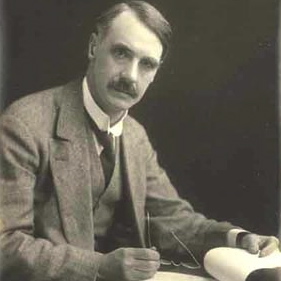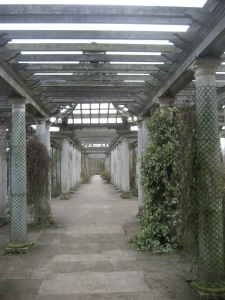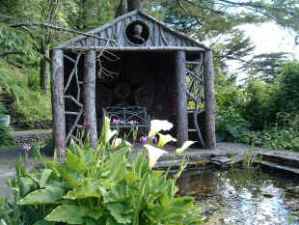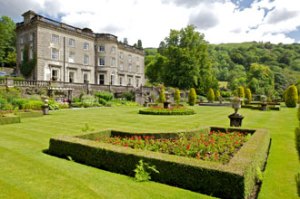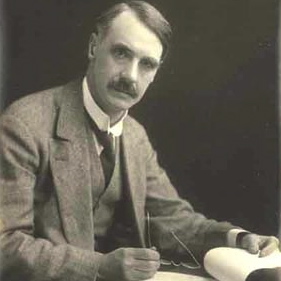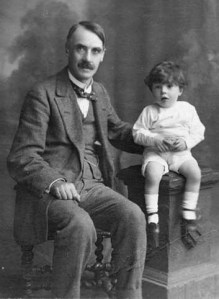




Sir Joseph Banks, 1st Baronet, GCB, PRS (24 February [O.S. 13 February] 1743 – 19 June 1820)[1] was an English naturalist, botanist and patron of the natural sciences.
Banks made his name on the 1766 natural history expedition to Newfoundland and Labrador. He took part in Captain James Cook’s first great voyage (1768–1771), visiting Brazil, Tahiti, and Australia, returning to immediate fame. He held the position of President of the Royal Society for over 41 years. He advised King George III on the Royal Botanic Gardens, Kew, and by sending botanists around the world to collect plants, he made Kew the world’s leading botanical gardens.
Banks advocated British settlement in New South Wales and colonisation of Australia, as well as the establishment of Botany Bay as a place for the reception of convicts, and advised the British government on all Australian matters.
He is credited with introducing the eucalyptus, acacia, and the genus named after him, Banksia to the Western world. Approximately 80 species of plants bear his name. He was the leading founder of the African Association and a member of the Society of Dilettanti which helped to establish the Royal Academy.
Biography
Banks was born in London to William Banks, a wealthy Lincolnshire country squire and member of the House of Commons, and his wife Sarah, daughter of William Bate. Joseph was educated at Harrow School from the age of 9, and at Eton College from 1756; his fellow students included Constantine John Phipps. As a boy, Banks enjoyed exploring the Lincolnshire countryside, and developed a keen interest in nature, history and botany. When he was 17, he was inoculated with smallpox, but he became ill and did not return to school. In late 1760, he was enrolled as a gentleman-commoner at the University of Oxford. At Oxford, he matriculated at Christ Church, where his studies were largely focused on natural history rather than the classical curriculum. Determined to receive botanical instruction, he paid the Cambridge botanist Israel Lyons to deliver a series of lectures at Oxford in 1764.
Banks left Oxford for Chelsea in December 1763. He continued to attend the university until 1764, but left that year without taking a degree.[4] His father had died in 1761, so when he turned 21 he inherited the impressive estate of Revesby Abbey, in Lincolnshire, becoming the local squire and magistrate, and sharing his time between Lincolnshire and London. From his mother’s home in Chelsea he kept up his interest in science by attending the Chelsea Physic Garden of the Worshipful Society of Apothecaries and the British Museum, where he met Daniel Solander. He began to make friends among the scientific men of his day and to correspond with Carl Linnaeus, whom he came to know through Solander. As Banks’s influence increased, he became an adviser to King George III and urged the monarch to support voyages of discovery to new lands, hoping to indulge his own interest in botany. He became a Freemason sometime before 1769.
Newfoundland and Labrador
In 1766 Banks was elected to the Royal Society, and in the same year, at 23, he went with Phipps aboard the frigate HMS Niger to Newfoundland and Labrador with a view to studying their natural history. He made his name by publishing the first Linnean descriptions of the plants and animals of Newfoundland and Labrador. His diary, describing his expedition to Newfoundland, was rediscovered recently in the Royal Geographical Society of South Australia. Banks also documented 34 species of birds, including the Great Auk, which became extinct in 1844. On 7 May, he noted a large number of “Penguins” swimming around the ship on the Grand Banks, and a specimen he collected in Chateau Bay, Labrador, was later identified as the Great Auk.
Endeavour voyage
Banks was appointed to a joint Royal Navy/Royal Society scientific expedition to the south Pacific Ocean on HMS Endeavour, 1768–1771. This was the first of James Cook’s voyages of discovery in that region. Banks funded seven others to join him: a Swedish naturalist Daniel Solander, a Finnish naturalist Herman Spöring, two artists, a scientific secretary, and two black servants from his estate.
The voyage went to Brazil, where Banks made the first scientific description of a now common garden plant, bougainvillea (named after Cook’s French counterpart, Louis Antoine de Bougainville), and to other parts of South America. The voyage then progressed to Tahiti (where the transit of Venus was observed, the overt purpose of the mission), to New Zealand and to the east coast of Australia, where Cook mapped the coastline and made landfall at Botany Bay and at Endeavour River (near modern Cooktown) in Queensland, where they spent almost seven weeks ashore while the ship was repaired after becoming holed on the Great Barrier Reef. While they were in Australia Banks, Daniel Solander and the Finnish botanist Dr. Herman Spöring Jr. made the first major collection of Australian flora, describing many species new to science. Almost 800 specimens were illustrated by the artist Sydney Parkinson and appear in Banks’ Florilegium, finally published in 35 volumes between 1980 and 1990.
Return home
Banks arrived back in England on 12 July 1771 and immediately became famous. He intended to go with Cook on his second voyage, which began on 13 May 1772, but difficulties arose about Banks’ scientific requirements on board Cook’s new ship, Resolution. The Admiralty regarded Banks’ demands as unacceptable and without prior warning withdrew his permission to sail. In July of the same year he and Daniel Solander visited the Isle of Wight, the western islands of Scotland and Iceland aboard Sir Lawrence and returned with many botanical specimens. In 1773, he toured south Wales in the company of artist Paul Sandby. When he settled in London he began work on his Florilegium. He kept in touch with most of the scientists of his time, was elected a foreign member of the Royal Swedish Academy of Sciences in 1773, and added a fresh interest when he was elected to the Dilettante Society in 1774. He was afterwards secretary of this society from 1778 to 1797. On 30 November 1778 he was elected President of the Royal Society, a position he was to hold with great distinction for over 41 years
In March 1779, Banks married Dorothea Hugessen, daughter of W. W. Hugessen, and settled in a large house at 32 Soho Square (now comprising British offices for 20th Century Fox). It continued to be his London residence for the remainder of his life. There he welcomed the scientists, students and authors of his period, and many distinguished foreign visitors. His sister Sarah Sophia Banks lived in the house with Banks and his wife. He had as librarian and curator of his collections Solander, Jonas Carlsson Dryander and Robert Brown in succession.
Also in 1779, Banks took a lease on an estate called Spring Grove, the former residence of Elisha Biscoe (1705–1776), which he eventually bought outright from Biscoe’s son also Elisha in 1808. The picture shows the house in 1815. Its thirty-four acres ran along the northern side of the London Road, Isleworth and contained a natural spring, which was an important attraction to him. Banks spent much time and effort on this secondary home. He steadily created a renowned botanical masterpiece on the estate, achieved primarily with many of the great variety of foreign plants he had collected on his extensive travels around the world, particularly to Australia and the South Seas. The surrounding district became known as ‘Spring Grove’.
The house was substantially extended and rebuilt by later owners and is now part of West Thames College.
Banks was made a baronet in 1781, three years after being elected president of the Royal Society. During much of this time he was an informal adviser to King George III on the Royal Botanic Gardens, Kew, a position that was formalised in 1797. Banks dispatched explorers and botanists to many parts of the world, and through these efforts Kew Gardens became arguably the pre-eminent botanical gardens in the world, with many species being introduced to Europe through them and through Chelsea Physic Garden and their head gardener John Fairbairn. He directly fostered several famous voyages, including that of George Vancouver to the northeastern Pacific (Pacific Northwest), and William Bligh’s voyages to transplant breadfruit from the South Pacific to the Caribbean islands. Banks was also a major financial supporter of William Smith in his decade-long efforts to create a geological map of England, the first geological map of an entire country. He also chose Allan Cunningham for voyages to Brazil and the north and northwest coasts of Australia to collect specimens.
Colonisation of New South Wales
It was Banks’s own time in Australia, however, that led to his interest in the British colonisation of that continent. He was to be the greatest proponent of settlement in New South Wales. A genus of Proteaceae was named in his honour as Banksia. In 1779 Banks, giving evidence before a committee of the House of Commons, had stated that in his opinion the place most eligible for the reception of convicts “was Botany Bay, on the coast of New Holland”, on the general grounds that, “it was not to be doubted that a Tract of Land such as New Holland, which was larger than the whole of Europe, would furnish Matter of advantageous Return”. His interest did not stop there, for when the settlement started, and for 20 years afterwards, his fostering care and influence was always being exercised. He was in fact the general adviser to the government on all Australian matters. He arranged that a large number of useful trees and plants should be sent out in the supply ship HMS Guardian which, however, was wrecked, and every vessel that came from New South Wales brought plants or animals or geological and other specimens to Banks. He was continually called on for help in developing the agriculture and trade of the colony, and his influence was used in connection with the sending out of early free settlers, one of whom, a young gardener George Suttor, afterwards wrote a memoir of Banks. The three earliest governors of the colony, Arthur Phillip, John Hunter, and Philip Gidley King, were continually in correspondence with him. Bligh was also appointed governor of New South Wales on Banks’s recommendation. He followed the explorations of Matthew Flinders, George Bass and Lieutenant James Grant, and among his paid helpers were George Caley, Robert Brown and Allan Cunningham.
Later life
He was elected a Foreign Honorary Member of the American Academy of Arts and Sciences in 1788. Among other activities, Banks found time to serve as a trustee of the British Museum for 42 years. He was High Sheriff of Lincolnshire in 1794.
Banks worked with Sir George Staunton in producing the official account of the British mission to the Chinese Imperial court. This diplomatic and trade mission was headed by Lord George Macartney. Although the Macartney Embassy returned to London without obtaining any concession from China, the mission could have been termed a success because it brought back detailed observations. This multi-volume work was taken chiefly from the papers of Lord Macartney and from the papers of Sir Erasmus Gower, who was Commander of the expedition. Banks was responsible for selecting and arranging engraving of the illustrations in this official record.
Banks’s health began to fail early in the 19th century and he suffered from gout every winter. After 1805 he practically lost the use of his legs and had to be wheeled to his meetings in a chair, but his mind remained as vigorous as ever. He had been a member of the Society of Antiquaries nearly all his life, and he developed an interest in archaeology in his later years. He was made an honorary founding member of the Wernerian Natural History Society of Edinburgh in 1808. In 1809, his friend Alexander Henry dedicated his travel book to him. In May 1820 he forwarded his resignation as president of the Royal Society, but withdrew it at the request of the council. He died on 19 June 1820 in Spring Grove House, Isleworth, and was buried at St Leonard’s Church, Heston. Lady Banks survived him, but there were no children.
Legacy
Banks was a major supporter of the internationalist nature of science, being actively involved both in keeping open the lines of communication with continental scientists during the Napoleonic Wars, and in introducing the British people to the wonders of the wider world. As befits someone with such a role in opening the South Pacific to Europe, his name dots the map of the region: Banks Peninsula on the South Island, New Zealand; the Banks Islands in modern-day Vanuatu; the Banks Strait between Tasmania and the Furneaux Islands; Banks Island in the Northwest Territories, Canada; and the Sir Joseph Banks Group in South Australia.
The Canberra suburb of Banks, the electoral Division of Banks, and the Sydney suburbs of Bankstown, Banksia and Banksmeadow are all named after him. Banks also appeared on the Australian currency paper $5 note before it was replaced by the later polymer currency.
In 1986 Banks was honoured on a postage stamp depicting his portrait issued by Australia Post.
In Lincoln The Sir Joseph Banks Conservatory can be found at The Lawn, Lincoln adjacent to Lincoln Castle. The conservatory is a popular tourist attraction with a tropical hot house themed with plants reminiscent of the voyages of its namesake, including many samples of vegetation from across the world, including Australia. There is also a plaque in Lincoln Cathedral in his honour.
In Boston, Lincolnshire Banks was Recorder for the town and a portrait painted in 1814 by Thomas Phillips was commissioned by the Corporation of Boston, as a tribute to one whose ‘judicious and active exertions improved and enriched this borough and neighbourhood’. It cost them just 100 guineas. The portrait is now hanging in the Council Chamber of the Guildhall Museum.
In Horncastle, Lincolnshire the Sir Joseph Banks Centre can be found. This is a Grade II listed building which was recently restored by the Heritage Trust of Lincolnshire to celebrate the life of Sir Joseph Banks. Horncastle is situated only a few miles from his Revesby estate and Banks himself was the town’s Lord of the Manor. The centre is located in Bridge Street, Horncastle, and boasts research facilities, historic links to Australia, and a garden in which rare plants can be viewed and purchased.
At the 2011 Chelsea Flower Show, an exhibition garden celebrated the historic link between naturalist Sir Joseph Banks and the botanical discoveries of flora and fauna on his journey through South America, Tahiti, New Zealand and eventually Australia on Captain Cook’s ship Endeavour. The competition garden was the entry of Melbourne’s Royal Botanic Gardens. Its Australian native-themed design was based on the metaphorical journey of water through the continent based on the award-winning Australian Garden at the Royal Botanic Gardens, Cranbourne. The design won a gold medal.
In 1911 the London County Council marked Banks’ house at 32 Soho Square, with a blue plaque. This was replaced in 1938 with a rectangular stone plaque commemorating Banks as well as botanists David Don and Robert Brown and meetings of the Linnean Society.
Banks appears in the historical novel “Mutiny on the Bounty” by Charles Nordhoff and James Norman Hall. He is also featured in Elizabeth Gilbert’s 2013 best-selling novel “The Signature of All Things.”




